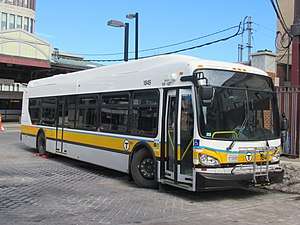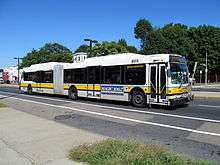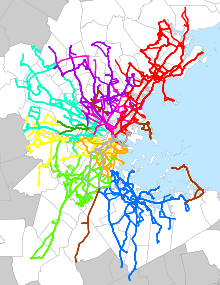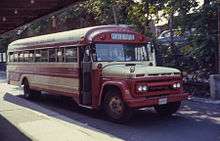MBTA bus
The Massachusetts Bay Transportation Authority operates 170 bus routes (list of routes) in the Greater Boston area, many of which were formerly part of a large streetcar system. Some routes are for local transport within the city; others bring passengers from surrounding areas to stops on the MBTA Commuter Rail or subway lines. The MBTA has a policy objective to provide transit service within walking distance (defined as 0.25 miles (0.40 km)) for all residents living in areas with population densities greater than 5,000 inhabitants per square mile (1,900/km2) within the MBTA's service district. Much of this service is provided by bus.
 A New Flyer XDE40 bus at Dudley station in 2017 | |||
| Parent | Massachusetts Bay Transportation Authority | ||
|---|---|---|---|
| Founded | 1964 (predecessors date to 1856) | ||
| Locale | Greater Boston | ||
| Service area | Boston and immediate suburbs | ||
| Service type | Local, limited stop, express, and Silver Line BRT | ||
| Routes | 170[1] | ||
| Fleet | 1100 (Active)[1] | ||
| Daily ridership | 387,815 (2013)[2] | ||
| Fuel type | Diesel, CNG, electric trolleybus, diesel-electric hybrid | ||
| Operator | MBTA; private operators | ||
| Website | mbta.com | ||
| |||
The MBTA operates a four-route bus rapid transit service branded as the Silver Line, as well as three crosstown routes that were intended to become the first part of the now-suspended Urban Ring project. Fifteen routes designed as key routes run with higher frequency at all times, including extended service hours on Friday and Saturday nights over some of these routes.
Most MBTA bus service is served by diesel, compressed natural gas, and diesel-electric hybrid buses. Silver Line routes running in the Waterfront tunnel use dual-mode buses that operate as trolleybuses in the tunnel and as diesel buses on the surface. Four routes based out of the Harvard bus tunnel run with trolleybuses in Cambridge and several surrounding suburbs.
All buses and routes are wheelchair-accessible (see MBTA accessibility); most of the MBTA's bus fleet consists of low-floor buses with wheelchair ramps, while older high-floor buses have lifts. All buses have LED exterior headsigns displaying route and destination, with automated audio/visual stop announcements for passengers.
After taking over operations in August 1964 from the former Metropolitan Transit Authority, the MBTA began rebranding many elements of Boston's public transportation network. After being found unsuitable in 1965 for what is now the Orange Line because it did not show up well on maps, yellow was chosen for the color of bus operations on January 8, 1972.[3][4]
The Boston Elevated Railway and MTA operated overnight Owl service until 1960. From September 2001 to June 2005, the MBTA operated bus service on 17 routes (7 normal bus routes and 10 routes replicating subway lines) until 2:30am on Friday and Saturday nights. Similar service on the key routes was operated from March 2013 to March 2014.[5] In 2017, the MBTA Board considered a proposal to run all-night service on several routes with pulsed connections at a central hub.[6]
Fleet
Active fleet
This is the current bus roster for the MBTA as of August 2020. All buses are 102 inches (260 cm) wide; most buses are 40-foot (12 m) length, while 102 are 60-foot (18 m) articulated buses.[1]
| Order Year | Manufacturer | Model | Picture | Fleet | Qty. | Active | Propulsion | Length (ft.) | Notes |
|---|---|---|---|---|---|---|---|---|---|
| 2004 | Neoplan USA | AN440LF |  |
4101–4128 | 28 | 28 | Electric trolleybus | 40 |
|
| 2004–2005 | Neoplan USA | AN440LF | %2C_March_2017.jpg) |
0401–0593 | 162 | 104 | Diesel | 40 |
|
| 2004–2005 | Neoplan USA | DMA-460LF |  |
1101–1132 | 32 | 32 | Dual mode | 60 |
|
| 2006–2007 | NFI | D40LF | 0600–0754 | 155 | 153 | Diesel | 40 | ||
| 2008 | NFI | D40LF | 0756–0910 | 155 | 155 | Diesel | 40 | ||
| 2010 | NFI | DE60LFR |  |
1200–1224 | 25 | 25 | Hybrid | 60 |
|
| 2014–2015 | NFI | XDE40 |  |
1400–1459 | 60 | 60 | Hybrid | 40 | |
| 2016–2017 | NFI | XN40 | 1600–1774 | 175 | 175 | CNG | 40 | ||
| 2016–2017 | NFI | XDE40 |  |
1775–1924 & 3000–3005 |
156 | 156 | Hybrid | 40 |
|
| 2016–2017 | NFI | XDE60 | 1250–1293 | 44 | 44 | Hybrid | 60 |
| |
| 2018 | NFI | XDE60 |  |
1294 | 1 | 1 | Hybrid | 60 |
|
| 2019 | NFI | XE60 |  |
1295–1299 | 5 | 5 | Battery-electric | 60 |
|
| 2019–2020 | NFI | XDE40 |  |
1925–2118 | 194 | 166 | Hybrid | 40 |
|
Future
Sixty additional XDE40 buses, an option order from a Virginia contract, will be delivered from September to December 2020.[1]
Potential future orders include the 45-bus option order for extended-battery range hybrid buses (of which #1294 is a test bus). The MBTA may begin a phased 500-bus order in 2020, with delivery from 2021–2025. Under that plan, the agency would establish a continuous procurement process with 100 new buses per year, and buses retired after 12 years.[1]
Facilities

|
Albany
Arborway
Cabot
Charlestown
Fellsway
Lynn |
North Cambridge
Quincy
Somerville
Southampton
Private carriers |
MBTA buses are operated out of nine facilities.[1] The MBTA plans to replace Quincy Garage with a larger facility near Quincy Adams station.[10]
| Name | Address | Routes | Times of Operation |
|---|---|---|---|
| Albany Street | 421 Albany Street, Boston | 4, 55, 57, 59, 60, 65, 170, 501, 502, 503, 504, 505, 553, 554, 556, 558, CT2, CT3 | Weekday rush hours and middays |
| Arborway | 3600 Washington Street, Jamaica Plain | 14, 21, 24, 26, 27, 29, 30, 31, 32, 33, 34, 34E, 35, 36, 37, 38, 39 (evenings), 40, 41, 42, 50, 51, 52 | Full-time |
| Cabot | 275 Dorchester Avenue, South Boston | 1, 7, 8, 9, 10, 11, 15, 16, 17, 18, 19, 22, 23, 43, 44, 45, 47, 66, 171 Also serves routes 55, 57, 59, 65, 504, and 553 when Albany Street is closed |
Full-time |
| Charlestown / Bennett (Somerville) | 21 Arlington Avenue, Charlestown | 61, 62, 64, 67, 68, 69, 70, 71, 72, 73, 74, 75, 76, 77, 78, 79, 80, 83, 84, 85, 86, 87, 88, 89, 91, 92, 93, 101, 104, 109, 110, 111, 112, 325, 326, 350, 351, 352 Also serves routes 90, 94, 95, 96, 97, 99, 100, 105, 106, 108, 132, 134, 136, 137, 411, and 430 when Fellsway Garage is closed, and routes 71 and 73 on Sundays |
Full-time |
| Fellsway | 465 Salem Street, Medford | 90, 94, 95, 96, 97, 99, 100, 105, 106, 108, 131, 132, 134, 136, 137, 354, 411, 430 | Weekday rush hours and middays |
| Lynn | 985 Western Avenue, Lynn | 114, 116, 117, 119, 120, 121, 424, 426, 428, 429, 434, 435, 436, 439, 441, 442, 450, 451, 455, 456, 465 | Full-time |
| North Cambridge | 2375 Massachusetts Avenue, Cambridge | 71, 73, 77A | Weekdays and Saturdays |
| Quincy | 954 Hancock Street, Quincy | 201, 202, 210, 211, 212, 214, 215, 216, 217, 220, 221, 222, 225, 226, 230, 236, 238, 240, 245 | Full-time |
| Southampton | 230 Southampton Street, Boston | 28, 39, Silver Line | Full-time |
Private buses

Most local bus routes in Massachusetts outside the immediate MBTA operating area are operated by the state's other regional transit authorities (RTAs). However, some routes that connect with MBTA bus or subway service are operated by outside private contractors with partial subsidy by the MBTA. [11]
Five routes – the 710, 712/713, 714, and 716 – are numbered like other MBTA buses. The five routes are primarily commuter routes which connect with other MBTA services at their inbound terminals. They were taken over from various private operators (Hudson Bus Lines for the 710 and 716, Rapid Transit Inc. for the 712/713, and Nantasket Transportation for the 714).[5] The 712 and 713 use MBTA-provided buses and accept Charliecards; the other routes do not.
Four suburban municipalities contract with outside operators for local circulator routes, most with partial MBTA subsidy. Bedford and Beverly run single routes, Burlington runs five routes, and Lexington runs six.[5] Most are run by private operators, except for the Beverly Shuttle, which is part of the Cape Ann Transportation Authority system. Additionally, a nonprofit shuttle is run in Boston's Mission Hill neighborhood.[5] Those routes appear on MBTA system maps and connect with MBTA services at designated transfer points, but are numbered separately and do not accept MBTA passes.
References
- "MBTA Vehicle Inventory". NETransit. Retrieved November 14, 2019.
- "Ridership and Service Statistics" (PDF) (14th ed.). Massachusetts Bay Transportation Authority. 2014.
- Tran, Andrew Ba (June 2012). "MBTA Orange Line's 111th anniversary". Boston Globe. p. 11. Archived from the original on July 21, 2017.
- A Chronicle of the Boston Transit System. Massachusetts Bay Transportation Authority. 1981. p. 8 – via Internet Archive.
- Belcher, Jonathan. "Changes to Transit Service in the MBTA district" (PDF). NETransit.
- Vaccaro, Adam (August 1, 2017). "MBTA may test overnight buses, Foxborough commuter rail". Boston Globe.
- "Baker-Polito Administration, State and Transportation Officials Celebrate the MBTA's First Extended-range Hybrid Bus in the MBTA Silver Line Fleet" (Press release). Massachusetts Department of Transportation. September 26, 2018.
- "Low or No Emission Vehicle Deployment Program Project Selections". Federal Transit Administration. 5 February 2015. Retrieved 2 July 2015.
- "First-Zero-emission-Battery-electric-Buses-Join-the-MBTA-Silver-Line-Fleet" (Press release). Massachusetts Bay Transportation Authority. July 31, 2019.
- "MBTA Bus Facility Modernization Program: New Quincy Maintenance Facility" (PDF). Massachusetts Bay Transportation Authority. January 29, 2020.
- "Private Bus". Massachusetts Bay Transportation Authority. Retrieved 22 July 2014.
External links
| Wikimedia Commons has media related to MBTA Bus. |
